I taught the 2024 LMS Defense Defensive Revolver course on the 26th of October in Northern California, and thought I’d share a few observations for the RevolverGuy crowd.
THE COURSE
The objective of the course is to provide students with a solid foundation for training with the defensive revolver. It’s not reasonable to expect students to train to proficiency within the framework of an eight-hour course, but I do want to teach them safe, efficient, and tactically-sound ways to operate their revolver, so they can use those newly-acquired skills and techniques as the basis for further practice and training. I want them to walk away knowing what to practice, and how to do it properly.
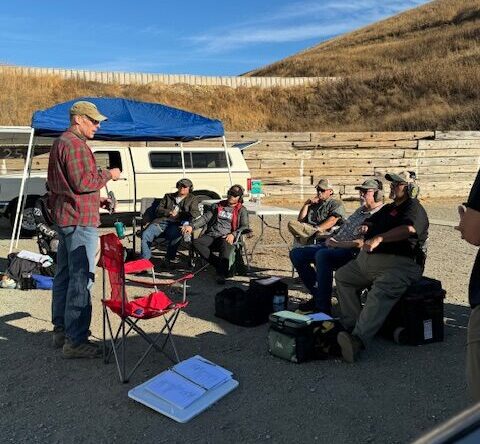
The coursework emphasizes safety protocols and proper handling procedures, because we’re going to handle and manipulate these guns a lot more than we’re going to shoot them in the real world. People who own revolvers for protection will load, unload, draw, holster, don, doff, transport, carry, conceal, store, clean, inspect, and maintain their revolvers much more than they will shoot them, and it’s vital that they understand and engrain the proper safety habits to avoid preventable tragedies. Your attacker is the one who’s supposed to be in jeopardy of getting hurt by your revolver, not you, your family, your friends, and the innocents that live around you! So, proper safe handling procedures are the foundation we build our house on.
It’s not sexy, but it is important.
PRIORITIES
Longtime readers will know that I’m fond of Massad Ayoob’s Priorities of Survival model, which emphasizes (in abbreviated form) Mindset, Tactics, Skills, and Equipment, in descending order. As such, my Defensive Revolver class is built around that hierarchy, and I try to deliver instruction in each of those categories to my students.
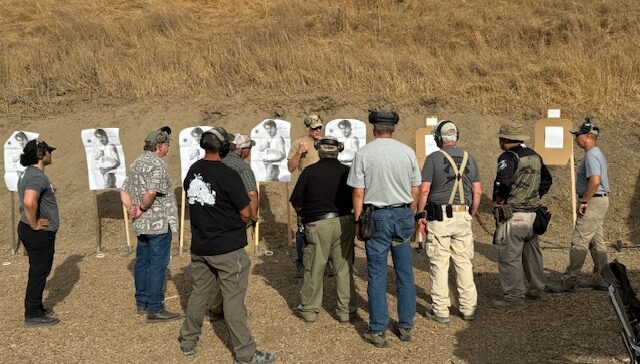
I obviously work hard to teach and develop the skills necessary to shoot the revolver and keep it running, but I don’t limit my instruction to the mechanics. I strive to integrate mental awareness and preparedness, tactics, and tactical considerations into the course as much as I can, because a student’s attention to those elements is even more important than their raw skill, and certainly much more important than the gear they carry.
THE STUDENTS
Just like last year, this year’s crop of students was diverse in their experience as shooters, and as revolver shooters, in particular. We had shooters from military and law enforcement backgrounds, competition shooting disciplines, and some “Normal Earth People,” as Pat Rogers was fond of saying. A great mix, from my point of view, and all of them were a pleasure to work with.

With a few exceptions, most didn’t have any formal training with the revolver. We did have two returning students from last year’s class that I was honored to have back, and one student who had taken Greg Ellifritz’s excellent snubby revolver class–that was going to be a tough act to follow, but the student didn’t look bored, so I think I did OK. Maybe he was busy calculating how many thin “Mike’s” Greg could bench press? ; ^ )
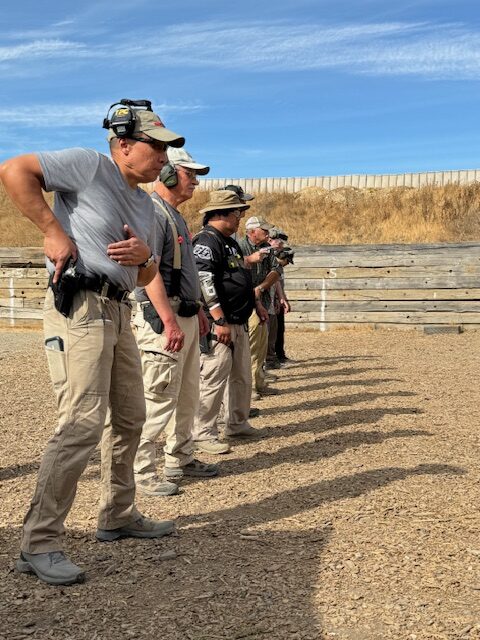
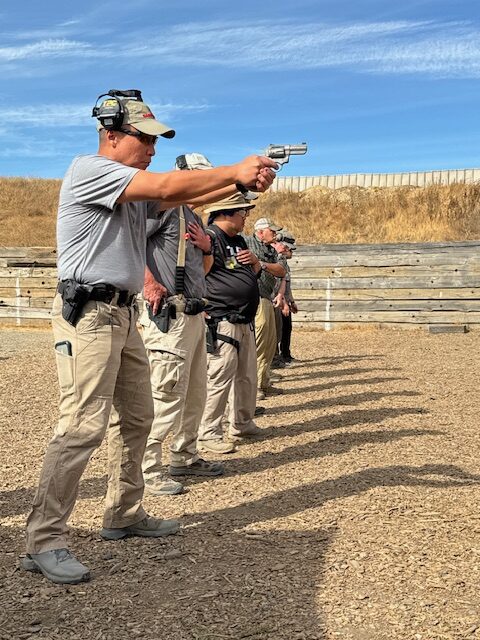
I want to assure everyone that you don’t have to be a revolver expert to come to a class like this one—that’s the whole idea, we want to teach you things that you don’t already know! Don’t let your inexperience stop you from going to classes like this, because they’re the perfect place to learn what you need. As you can see, even our most experienced and capable shooters didn’t have much, if any, formal revolver training in their resumes. That’s part of the fun in a class like this, so if you’ve been thinking about taking a revolver class from Ellifritz, Haggard, Burch, Dobbs, Bolke and Eastridge, Werner, or any number of outstanding instructors that I haven’t mentioned, you can rest assured that your fellow students will look a lot like you.
FOR YOU GEARHEADS
Readers are always interested in the gear that shows up at these classes, and I have to admit I’m guilty of not taking very good notes but I’ll do my best to remember.
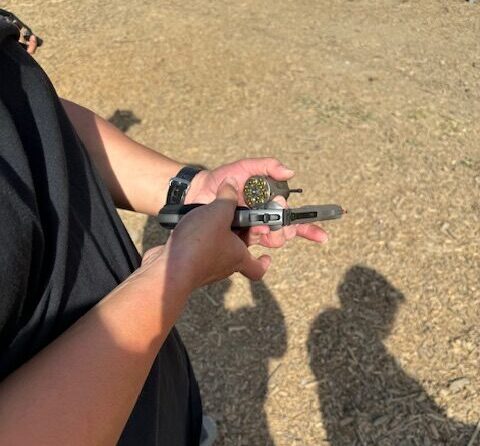
We had a couple shooters using pre-lock, K-Frame .38 Specials (one 3” and one 4” that I recall), and a few shooting lock-equipped Model 686s. One shooter was training with a .45 ACP N-frame with moon clips.
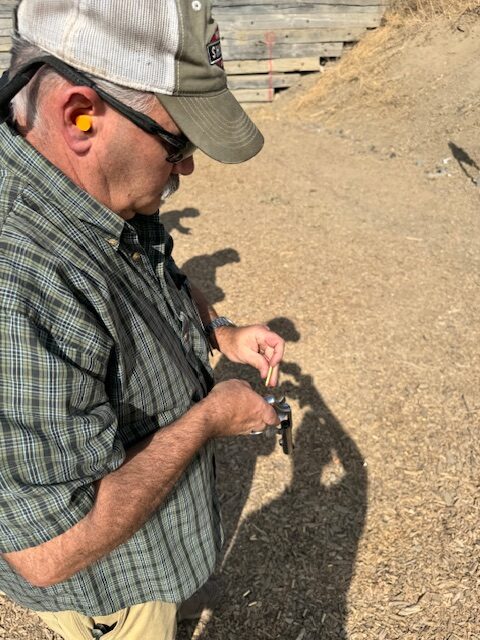
Ruger was represented as well, with one shooter trading off between a GP100 and a SP101, and two students shooting LCRs in less common chamberings—one 9mm, and one .327 Fed Mag (that was fed with .32 Longs all day—some RN and some WC). There may have even been a special edition .357 Magnum GP100 in the mix.
Holsters ran the gamut, with a few drop-leg rigs, an IWB or two, and some OWB scabbards. Our N-frame shooter used a Sam Browne duty rig with a Jordan-style holster that pegged my nostalgia meter and made me smile. There were two shooters using appendix IWB rigs.
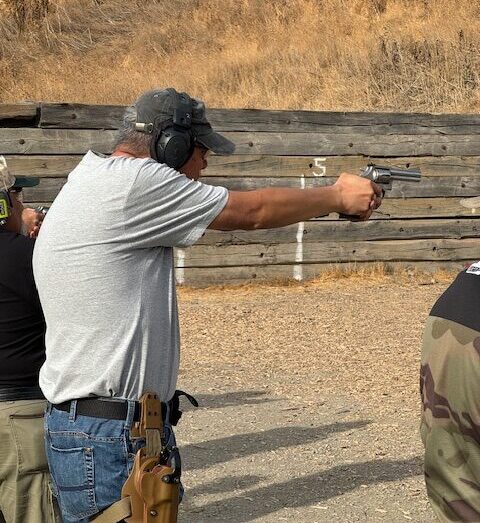
We had a mix of loading devices. Obviously, a few of the shooters were using moon clips. I saw some Safariland Comp IIs, some Zeta6 K-Clips, and plenty of strip loaders. There was also a K-frame SpeedBeez floating around. I don’t specifically recall any HKS loaders, outside of my own, but that could just be my faulty memory. No 5-Star loaders, either, this time, although they’re usually present.
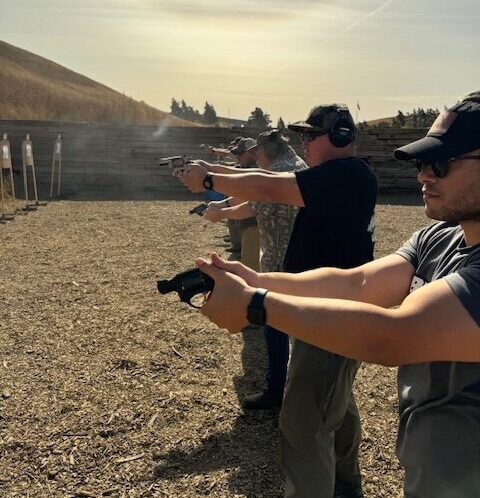 What’s more interesting to me are the things that I don’t see at these classes. I don’t see any Kimber or Colt revolvers, even though they’re making some really good ones that would be dandy carry guns. The Taurus guns were also conspicuously absent, given the metric tons of Model 856s that are being sold these days–they’re easily one of the top two or three, by volume. Solid values, and I’m surprised they don’t show up more often in class. Maybe folks bring their fancy guns to school, and leave their utility guns at home?
What’s more interesting to me are the things that I don’t see at these classes. I don’t see any Kimber or Colt revolvers, even though they’re making some really good ones that would be dandy carry guns. The Taurus guns were also conspicuously absent, given the metric tons of Model 856s that are being sold these days–they’re easily one of the top two or three, by volume. Solid values, and I’m surprised they don’t show up more often in class. Maybe folks bring their fancy guns to school, and leave their utility guns at home?
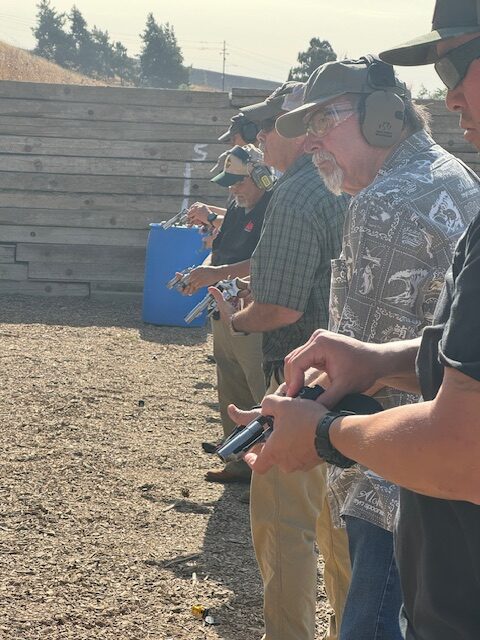
I also don’t see many lock-equipped Smith & Wessons—it seems that most folks still prefer to shoot the older guns, if they can get them. We had a few lock-equipped L-frames, as I mentioned, but I don’t think I’ve ever seen a lock-equipped K-frame at any of the revolver schools or classes I’ve attended as student or instructor. There’s probably an important message buried in there.
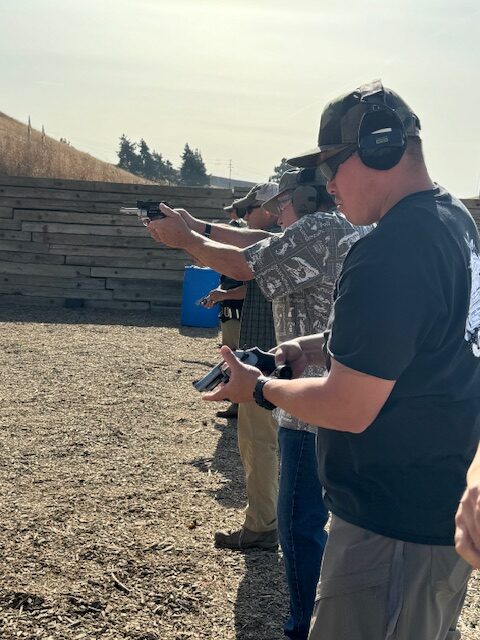
SOME TRAINING PHILOSOPHY
I won’t dive deep into the specifics of the syllabus, but do want to say that I design the course so that each block builds on the next, and the demand on the student builds throughout the day, as they integrate all the skills into a single performance.
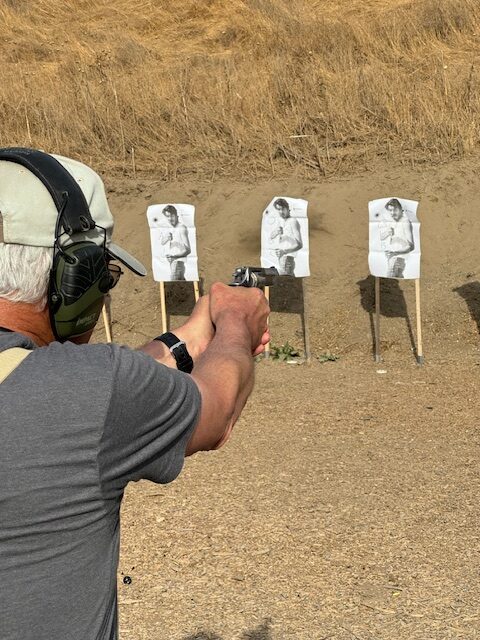
We do some drills and exercises at the end of the day which require the students to do some problem solving and make some decisions with the gun in hand, and they get more complex as we go along, to increase the cognitive load. We use some timed team competitions to achieve the same effect, because they’re a fun way to introduce some additional training stress.

When you get right down to it, most armed citizen gunfights don’t require extraordinary shooting skills to solve the problem, but they do require some really good awareness, thinking, and decision making, so I think our training should reflect these realities.
We could bang away at paper or steel all day and turn a lot of money into noise, but what would we achieve? If training for a lethal encounter is the goal, it’s far better to exercise your thinking skills as much as your shooting skills, in my opinion. I don’t mean to diminish the importance of your hard skills, but your soft skills need a workout too, and we don’t often see that in training programs.
A NUGGET
Before I wrap up this wandering non-debrief, I want to share a conversation that I had with one of the students after class, because I think it’s important.
We were talking about the topic of reloading the revolver, and comparing the method I preferred to some of the other methods that we discussed and observed in the class. I’d taught all the students how to perform the Stressfire Reload with a round body speedloader during the class, and encouraged them to practice it in class and at home, and give it a fair evaluation. I admitted there were other methods that might be faster, but I felt the Stressfire was superior because it was more robust and reliable.
This is a hard thing for many shooters to accept, because they’ve been trained to think that faster equals “better,” largely as a result of competitive shooting sports that place a priority on the clock. In some of the sports, time is such a critical measure, that a shooter can even override the effect of a missed shot if he shoots quickly enough.
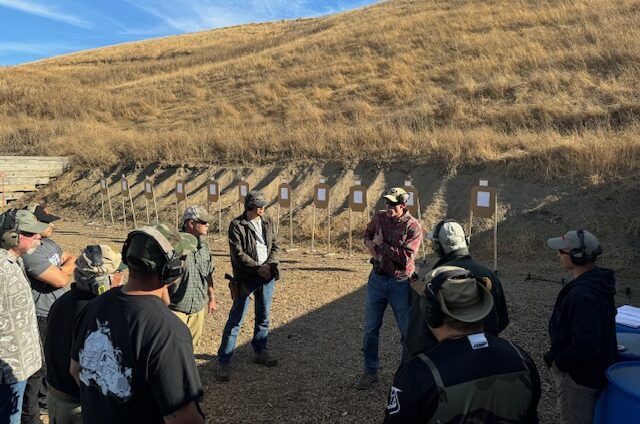
A gunfight is certainly no place to dawdle, and we need to work as efficiently as we can to solve our problem in the least possible time, but I don’t think we should be slaves to the clock in our defensive training. There actually ARE some things that are more important than speed, like accuracy, for example–you can’t miss quickly enough to win in the real world, even if it will make you a victor in some of the games.
Reliability is another one of those things that’s more important than speed. When it comes to training for emergencies, I wouldn’t trade a reliable technique for one that is marginally faster, but more prone to interruption, error, or failure.
In the case of emergency reloading, for example, I wouldn’t favor a technique that keeps the gun in the primary hand, and parallel to the deck, when the empty cases are ejected. The gun can be emptied very quickly that way, but it also greatly increases the risk of powder fouling or a spent case getting trapped behind the extractor star. Either of those conditions could make your revolver stop revolving, most riki-tik.
That would be a bad thing in a fight, for those of you keeping score. A very bad thing.
Instead, I prefer unloading techniques that orient the muzzle straight up towards the Heavens, encourage powder residue to stay inside the cases (instead of dribbling out and polluting the gun), and allow those cases to take advantage of gravity, instead of fighting it. An emergency reloading technique that is marginally slower, but more likely to result in a clean, positive ejection of spent cases, is a winner when your life is at stake, by my calculus.
There may be faster options, but they’re not better options. At least not for combat. For competition maybe, but not for combat. Now, I don’t expect most gunfights would even afford an opportunity to reload in the middle of hostilities, but if you ever have to, your technique had better work right the first time.
I guess that’s all a roundabout way to emphasize the importance of context in your training. If you’re training for the games, it will lead you down one path, but if you’re training to protect innocent life, that path will often diverge from the other. Make sure you choose the right one for your mission.
WRAP UP
I’ve used up all the soap in my soapbox for now, so I’ll close with my thanks to LMS Defense for being such excellent hosts for this class. They are always a pleasure to work with, and I appreciate the opportunity to collaborate with them on these classes. I’d encourage readers to have a look at the variety of training courses they offer and their busy calendar. I can vouch that you’ll get quality training from them.
I would also like to thank all the students who showed up for the class. It was an honor to work with you gents, and I enjoyed it very much. I wish you all the best and hope you’ll be safe out there. Please make yourselves at home here at RevolverGuy and stay a while.
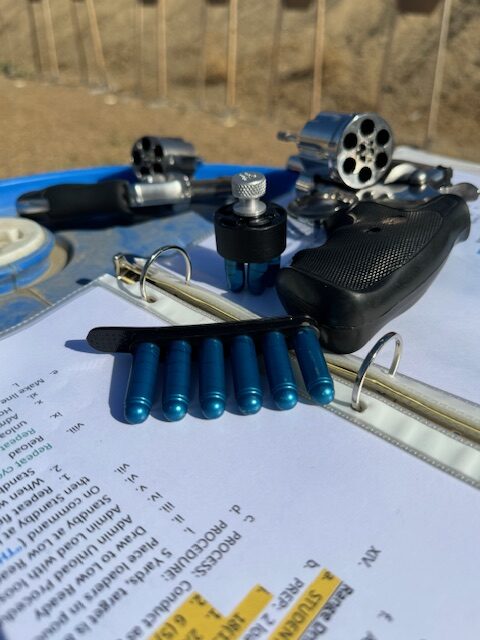
If you missed out on this class and would be interested in attending a future version, please keep an eye on the LMS Defense website. We’re already talking about plans for 2025, which may include a multi-day format, if there’s sufficient demand for it.
Until then, train hard, train smart, and be safe out there!

Although I’m not sure where in Northern California this defensive revolver course took place, it looks like the I-5 area between Sacramento and Red Bluff. The shooting range seems spacious and provides excellent backstops–a good place to hold such a class.
The 2023 class was near Sacramento, but this year we shifted to a range in the Northeast Bay foothills. It was a good facility, and we’ll probably return there in 2025
In my teaching days, I taught my students to move to cover to reload, regardless of type of firearm. Despite the fact that this usually involved only a single step to the side in my range drills, it sometimes required reminders to students accustomed to shooting against the clock, at targets that couldn’t shoot back.
I recall an account of Jim Cirillo visiting Jeff Cooper at Gunsite and being asked to shoot one of the donga courses. Rather than follow the established trail, Jim sought out the threat targets slowly and left the trail to flank them – a technique that would have taken a real ambusher by surprise.
I hadn’t heard the Cirillo story before–that’s excellent!
Agreed on seeking cover. We discussed the importance of that in the class. No sense standing in the open, while you’re temporarily out of commission.
As one of the class attendees, I have to commend Mike for putting on an excellent course. The class structure was logical and flowed well. The learning points were clearly explained. The exercises/drills were well chosen for the specific topics covered in each block of instruction.
Mike’s curriculum allowed for different variations of certain techniques and I appreciated that…it meant I would have some homework post-class to really shake out what techniques worked best for me and for the revolver gear I commonly use.
For the class, I used a Ruger GP100 3 inch Wiley Clap version, Safariland Comp II speedloaders and a Milt Sparks leather scabbard. All well during the class with no issues.
I would highly recommend this course to anyone who has a revolver available to them. I look forward to training with Mike again in the near future.
Thank you Sir, I really appreciate that! I look forward to doing more shooting with you, and learning from you as well.
Thank you again for teaching this class, Mr. Mike. I enjoyed it thoroughly. You did a great job maintaining a safe training environment. I found it refreshing that, for a course that focused a lot on mechanics, you still made plenty of time to discuss the broader context of real life armed defense. I left the range that day feeling more confident in my skills and with more perspective on the things I can be working on in my practice moving forward to become more capable.
Thank you again!
P.S. you’re rocking those bunny ears
Kevin, I’m grateful for the feedback and glad you found the class so useful. I’m happy to hear you say we struck the right balance between mindset, tactics, and skills.
That was a good ambush with the bunny ears. I laughed hard when I saw that!
This looks like it was great. I found last year’s class quite valuable, and I’m bummed my schedule didn’t permit me to go this year. Maybe in 2025…
Tyson, we missed you, but look forward to seeing you next time. Hope you’ve been well!
Pity Georgia is such a long bicycle ride from Sacramento . . . but as one of the slightly abnormal earth people, I can attest that mindset and threat assessment are two primary elements to surviving a hostile confrontation.
One can have the best equipment, holsters, speed loaders, and so on, but if you can not deploy the hardware effectively, then it’s a lot of show and no go. Gun handling to a large degree becomes a function of muscle memory, particularly ‘speed’ reloading a sixgun. You’ll find a reliable technique that you can master, and repetition becomes somewhat reflexive – and a mild chamfer on the charge holes doesn’t hurt. Mike is exactly correct, as I learned as a rookie, that in a reload, pointing that muzzle straight up while ejecting empties is the fastest best option. Having a spent case slip under the extractor – hopefully in practice only – will hammer home that gravity is your friend.
Mindset, on the other hand, is fluid. When stuff hits the fan, time slows down, and distractions may or may not be part of the overall threat situation. No two situations will be the same either with surroundings, scenario, or individuals involved. It takes practice to think faster than you react, and make the right decision (fingers crossed).
One never gets over the fear – that’s a survival instinct; but, one can learn to channel that fear for survival. There has been more than one situation where the GO signal in the brain activated, and the gun cleared leather, only to have to slam the brakes on the moment the front sight aligned with the perp who, at that instant, decided he wanted to live to see another day.
As for equipment – I am not surprised at the number of Hildebeeste locks in the class. I wouldn’t trust one in any gun I would use as a defensive tool . . . the main reason I refuse to own any S&Ws with that contraption. Maybe someday, in a galaxy far, far away, S&W will spend $5 and buy a clue on that hiddeous concept. The lack of Colt revolvers, especially the newer generation, is curious.
Always grateful that you share your experience with us here, Sir! I know this hasn’t been just a theoretical thing for you, and it’s always useful to hear from folks who’ve been there, done that.
On this training topic, a friend told me the story about how the sheriff of Bodie, California met his demise in July 2015. Sheriff James Dolan was called out to apprehend some crooks on horseback, and when the gunplay began Dolan found himself equipped with an unfamiliar handgun that had been gifted to him! Unable to defend himself, he was an easy kill for the bad guys. Some speculate the sheriff’s “gift” sidearm was a 1911, but whatever it was he failed to deploy it effectively!
Correction to the above: Sheriff Dolan was killed in July 1915, NOT 2015.
Thanks Ricky, that’s a powerful example of how important it is to be skilled with your gear. The Sheriff had good equipment from the sound of it, but wasn’t ready to take advantage of it. Tragic.
Like so many mining towns, Bodie was a California boomtown that had its heyday in the late nineteenth century. By the 1880s, the gold ore was playing out. Yet by the 1890s, mining technology improved and there was a brief revival. However, that was short-lived and by 1915 Bodie was considered a ghost town. A few hardy folks lingered there for some years, but my God it’s remote and miserably cold most of the year.
In its early days, the town had an evil, lawless reputation, though probably much of it was exaggerated by the press. And as most mining towns, Bodie was a “get rich quick” venue and soon its transient denizens migrated to other precious metal hot spots throughout the Far West.
Considerable old buildings remain in Bodie, which is recognized as both a National Historic Landmark and a California Historic Landmark, plus it is preserved in “arrested decay” as a state park. The ghost town is a little off the beaten path (US Hwy 395), but it’s definitely worth a visit. Bring your camera and spend some time there!
The actual records of Bodie CA and Aurora CO – both reported to have been “Wild West” towns – were reviewed by David Kopel in his 1992 book [i]The Samurai, the Mountie and the Cowboy: Should America Adopt the Gun Controls of Other Democracies?[/i]. He found the gate books for their jails to be very similar to that of most American cities of three decades ago – most arrests were for misdemeanor offenses such as drunk and disorderly.
I wish I could’ve attended your class in Northern California last month. I’m also in Georgia which my fellow RevolverGuy, s. bond, points out “is a long bicycle ride.” Heck, that’s a fairly long ride from here on a Harley! Can you refer me to any combat revolver classes relatively close to my newly adopted home? Thanks!
Our friends at American Fighting Revolver are busy planning the first annual RevolverFest in October 2025, which will be held in South Carolina. It will be a three-day event with a vendor show on the front end, and two days of training following. They’ll have an A-List of instructors doing the training. That should be much closer for you.
I see that Claude Werner (The Tactical Professor) taught his Revolver Operator Course several times this year in Dahlonega, GA, at the invitation of The Complete Combatant. I’d keep an eye on those two websites for dates in 2025. I’d bet that location isn’t far from you.
As always, your thoughts and observations are on point and top notch.
Thanks Mike
Rob
Thank you Sir! That’s high praise, coming from you.
Your statement that you didn’t see any lock-equipped K-frames makes a lot of sense when you consider that S&W discontinued most of the K-frames (13, 14, 15, 19, 64, 65, 66, and 67) about the time it introduced the new lockwork and the locks, and only recently started making 19s and 66s again. So anyone who wanted to carry a K-frame would almost automatically be limited to pre-lock models.
That looks like a fun and informative class. Too bad it’s on the wrong side of the country for me.
A good point, 1811. I don’t think I’ve seen any of the new Model 66s in the wild. There are plenty of 686 variants, but none of the new K’s. I think the lock has a lot to do with it.
I wish I could cover more of the map with the classes!